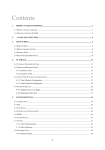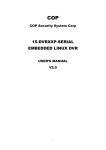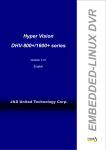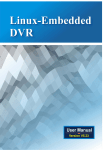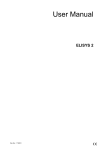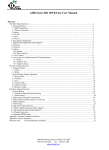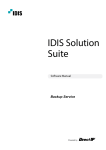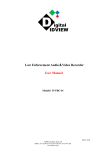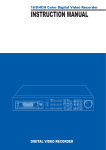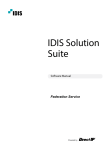Download 5-8-1
Transcript
Copyright © 2004 Digital IDView EMBEDDED-LINUX DVR Revised Edition November 2004 All rights reserved. This material, information and instructions for use contained herein are the property of Digital IDView Norof this manual, including the products and software described in it, may be reproduced, transmitted, transcribed, stored in a retrieval system, or translated into any languages in any form or by any means, except documentation kept by the purchaser for backup purposes, without the express written permission of Digital IDView Digital IDView CYSX/SV+/Real Time User Manual Liability. Digital IDView provides this manual “AS IS” without warranty of any kind, either express or implied, including but not limited to the implied warranties or conditions of merchantability or fitness for a particular Version 4.03 purpose. In no event shall Digital IDView, its directors, officers, employees or agents be liable for any indirect, special, incidental, or consequential damages (including damages for loss of profits, loss of business, loss of use or data, interruption English of business and the like), even if Digital IDView has been advised of the possibility of such damages arising from any defect or error in this manual or product. Specifications or information contained in this manual are furnished for informational use only, and are subject to change at any time without notice, and should not be constructed as a commitment by Digital IDView Digital IDView assumes no responsibility or liability for any errors or inaccuracies that may appear in this manual, including the products and software described in it. Trademarks. Product and cooperate names appearing in this manual may or may not be registered trademarks or copyrights of their respective companies, and are used only for identification or explanation and to the owners’ benefit, without intent to infringe. Translated material. Any discrepancies, errors or omissions in non-English versions of this manual should be referenced to the English version for clarification. Digital IDView Telephone: +886 (3) 553 8998 8F, No. 147, Fax: +886 (3) 553 8968 th Hsien-cheng 9 Road, World Wide Web: Chu-pei City, Hsin-chu Hsien, Email – Sales & Enquires: [email protected] Taiwan R.O.C. Email – Technical Support: [email protected] http://www.cybervision.com.tw Digital IDView Card Kit User Manual 2nd Edition Dec, 2006 Copyright © 2000-2006 Digital IDView All rights reserved. This material, information and instructions for use contained herein are the property of Digital IDView No part of this manual, including the products and software described in it, may be reproduced, transmitted, transcribed, stored in a retrieval system, or translated into any languages in any form or by any means, except documentation kept by the purchaser for backup purposes, without the express written permission of Digital IDView Liability. Digital IDView provides this manual “AS IS” without warranty of any kind, either express or implied, including but not limited to the implied warranties or conditions of merchantability or fitness for a particular purpose. In no event shall Digital IDView, its directors, officers, employees or agents be liable for any indirect, special, incidental, or consequential damages (including damages for loss of profits, loss of business, loss of use or data, interruption of business and the like), even if Digital IDView has been advised of the possibility of such damages arising from any defect or error in this manual or product. Specifications or information contained in this manual are furnished for informational use only, and are subject to change at any time without notice, and should not be constructed as a commitment by Digital IDView Digital IDView assumes no responsibility or liability for any errors or inaccuracies that may appear in this manual, including the products and software described in it. Trademarks. Product and cooperate names appearing in this manual may or may not be registered trademarks or copyrights of their respective companies, and are used only for identification or explanation and to the owners’ benefit, without intent to infringe. Translated material. Any discrepancies, errors or omissions in non-English versions of this manual should be referenced to the English version for clarification. Digital IDView Telephone: 972-247-1203 12000 Ford Rd. #110 Dallas, TX 75234 Fax: 972-247-1291 World Wide Web: http://www.DigitalIDView.com Email – Sales & Enquires: [email protected] Email – Technical Support: [email protected] ii Contents 1. PRODUCT CHARACTERISTICS...............................................................................................................1 1-1 PRODUCT CHARACTERISTICS ...........................................................................................................................1 1-2 MAIN FEATURES...............................................................................................................................................3 2. LANGUAGE SELECTION...........................................................................................................................6 3. MAIN SCREEN..............................................................................................................................................7 3-1 DISPLAY MODE ................................................................................................................................................9 3-2 MOTION/ALARM TO ZOOM.............................................................................................................................10 3-3 STORAGE SPACE .............................................................................................................................................14 3-4 RECORDING & DI/DO STATUS .......................................................................................................................15 4. PLAYBACK ..................................................................................................................................................16 4-1 PLAYBACK PASSWORD SETTING .....................................................................................................................18 4-2 SEARCH FOR RECORDED DATA .......................................................................................................................19 4-2-1 Search by Time .....................................................................................................................................19 4-2-2 Search by Event ....................................................................................................................................20 4-3 AUDIO/VIDEO PLAYBACK CONFIGURATION ...................................................................................................29 4-3-1 Video Playback Configuration ..............................................................................................................29 4-3-2 Audio Playback Configuration..............................................................................................................30 4-4 SNAPSHOT/BACKUP .......................................................................................................................................31 4-4-1 Snapshot and save to floppy..................................................................................................................31 4-4-2 Backing up Video Files .........................................................................................................................32 5. SYSTEM SETTINGS...................................................................................................................................35 5-1 CAMERA SETUP ..............................................................................................................................................36 5-2 PTZ................................................................................................................................................................40 5-3 VIEW SETUP ...................................................................................................................................................42 5-4 USER ACCOUNT MANAGEMENT .....................................................................................................................43 5-5 DI/DO............................................................................................................................................................46 5-6 ALARM NOTICE ..............................................................................................................................................48 5-7 SYSTEM ..........................................................................................................................................................53 5-7-1 Time Synchronization ...........................................................................................................................54 5-7-2 Other Functions.....................................................................................................................................56 5-8 NETWORK SETUP ...........................................................................................................................................57 5-8-1、Remote Connection via Internet by a modem ....................................................................................62 iii 5-8-2、Remote Connection when SV Series is connected to the Internet by a modem.................................69 5-9 DISK ...............................................................................................................................................................75 5-10 AUDIO ..........................................................................................................................................................76 5-11 VOICE DIALER ..............................................................................................................................................77 6. REMOTE OPERATION..............................................................................................................................78 6-1 DOWNLOAD PLAYER ......................................................................................................................................79 6-2 REMOTE MONITOR VIA MPEG4.....................................................................................................................79 6-3 REMOTE MONITOR VIA JPEG.........................................................................................................................82 6-4 REMOTE PLAYBACK .......................................................................................................................................83 6-5 DVR PLAYER .................................................................................................................................................87 6-6 DVR REMOTE SETUP .....................................................................................................................................90 6-6-1 Remote Setup Record............................................................................................................................90 6-7 DVR REMOTE BACKUP ..................................................................................................................................92 7. APPENDIX ...................................................................................................................................................93 A.COMPATIBLE PC HARDWARE ............................................................................................................................93 B.MAIN MENU .....................................................................................................................................................96 C.FAQ .................................................................................................................................................................98 D.INTERNET CONNECTION ................................................................................................................................ 100 E.MAINTENANCE ...............................................................................................................................................102 F.WARRANTY .....................................................................................................................................................103 G.CUSTOMER SERVICE .......................................................................................................................................104 iv 1. Product Characteristics 1-1 Product Characteristics Optimum Replacement for Time-lapse Recorder Traditional Time-lapse Recorder is a mechanical device. It is very easy to break down after long-term operation and it causes many problems such as: the overly used magnetic heads which cause blurred image; tapes need to be changed often and manually; the recording time is not long enough; the management of recorded tapes is complicated; inefficient when trying to locate the needed data; recording a huge amount of useless images, etc. Digital IDView DVR adopts digital recording technology. The quality of images will not deteriorate with time. With its high compression rate, the storage time can last for months under normal applications. The overwrite operation mode will overwrite the earliest data, and no more tape change is required. Motion detection function will enable the recording only when there is motion of the objective, and makes the system and data retrieval more efficient. High Reliability Normal PC digital surveillance system adopts the MS-Windows OS (Operating Systems). Such kind of system is so often to crash. It usually makes a negative impression which digital surveillance system is unreliable. Digital IDView DVR adopts Embedded-Linux OS. Our advanced embedded technology condenses the entire system into a tiny flash module, which makes the system more reliable. Even when the power fails, the system will re-boot and return to normal operation in less than one minute. Longer Recording Days Digital IDView DVR adopts the advanced MPEG-4 compression to store the video images. It allows you to record more data on the same capacity of hard disks. 1 Ease of Operation Mouse clicking on the Graphical User Interface controls all the operations. No keyboard is needed so that it is most suitable for the security guards and normal non-IT based users to use. Multi-Function Function of one set of Digital IDView DVR = Time-lapse Video Cassette Recorder + Multiplexer processor + Motion Detection Processor You can backup the data to CD-R/RW, remotely monitor the images and still recording the current video data at the same time. 2 1-2 Main Features Items OS Description Embedded Linux *4/8/12/16 channels in BNC jack for SV, SV1000 Video Inputs *8/16 channels for SV+ *16 channels for SV2000 System Video Outputs D type 15 Pins VGA and TV-Out Video Format NTSC/PAL *1 Channel input and 1 Channel Output for SV, SV+ Audio Input/Output *4 channel inputs (optional) and 1 channel output for SV1000 *4 channel inputs and 1 channel output for SV2000 Display PC Interface PCI Slot Multi-Tasking Yes User Interface 800*600, very user friendly Frame rate Real time display Resolution 640*480 HDD Usage Display Yes Hidden Camera Yes Video Loss Detection Yes Image Parameter Adjustment Brightness/Contrast/Hue/Saturation for each camera Recording Compression MPEG 4 like Compression Resolution 640*480,640*240,320*240 *NTSC:30/60/90/120, PAL:25/50/75/100 @320*240 for SV Frame rate *NTSC:120/240, PAL:100/200 @320*240 for SV+ *NTSC:120/240/240/240, PAL:100/200/200/200 @320*240 for SV+ *NTSC:400, PAL:400 for SV2000 Pre-Schedule Recording Motion detection area By 7days x 24hours, set each hour as: recording by motion, continuously recording, non-recording Define any 8x8 cell for motion detection. Free combinations of detected areas. No limitation on the number of detection areas. Motion detection sensitivity 10 ranges per camera Pre-Recording 0~10 sec Post-Recording 0~20 sec Watermark Yes 3 Date Code Playback 4 channels playback at the same time Playback mode Play, Pause, frame by frame play, fast forward, fast backward Video Enhancement De-interlace, Sharpen Search Search by time, date and event. Image Adjustment Brightness/Contrast Remote Monitoring Remote Remote Playback Internet/PSTN/LAN by Ethernet/ Modem (Fix IP, PPPoE/DDNS, DHCP) JPEG mode or MPEG 4 streaming. Remote 4 and 16 channel playback with MPEG 4 Streaming Technology. Remote Setup Yes Download and Local Play Yes Central Management Yes Remote Backup by Windows Network Neighborhood i-Mode Yes Inputs Alarm To prevent date code from being modified Playback channels Networking Functions Recording includes time/date information. Outputs IO & Camera Relations Alarm Behavior *4/8/12/16 NC/NO dry contact inputs for SV, SV+ and SV1000 *4/8 NC/NO dry contact inputs for SV2000 *4/8/12/16 NC/NO relay for SV, SV+ and SV1000 *4/8 NC/NO relay for SV2000, 1-1, 1-many, many-1, many-many * Alarm to Zoom, Alarm to recording, Alarm to Notice (by Email / FTP / SMS), Alarm to DI output HDD Interface Support IDE & SATA HDDs RAID support Support IDE/SCSI RAID Storage & Backup Other Backup USB/ IDE burning device(CD-R/RW, DVD±R/RW) ; USB storage (Pen Drive, HDD) HDD SMART Diagnostics Yes Password protection 100 user accounts, each one can see different cameras PTZ camera support Yes Power Down Management Yes. Auto-recovery when power back Watchdog Yes Hardware Watchdog. Time Zone/Daylight Saving Yes AVI Format Export Yes 4 Time Sync UI Language Support Time Server, FM and RTC Time Sync 7 languages in single software: English, French, German, Japanese, Portuguese, Spanish, Traditional Chinese * Specifications subject to change without notice 5 2. Language Selection You can select your preferred display language at “Main Menu” before starting DVR system. There are seven languages that are supported in this version- Traditional Chinese, English, Japanese, French, German, Portuguese, and Spanish. 6 3. Main Screen After turning on the DVR, launch the DVR program and it will show the following main screen, 1 2 9 8 7 6 5 7 4 3 The controls in the main screen including: Function Description 1 Storage Space Indicate the HD free space status 2 Recording/ DI/DO Status Camera recording status and alarm/sensor input and output status 3 System Setting Quick access to system configuration 4 Playback Quick access to playback mode 5 Full Screen Monitoring Monitor in full Screen 6 Date/Time Display current date and time 7 Display Mode Select display divisions 8 Motion/Alarm to Zoom Activate zooming function when motion or alarm occurs 9 Sequencer Display in sequence Note: Whenever you click this button , the system will return to the main screen. 8 3-1 Display Mode There are 7 kinds of Display mode, 4 splits, 6 splits, 8 splits, 9 splits, 10 splits, 13 splits, and 16 splits. The default display mode is 16 splits. The cameras displayed on each split mode can be configured in the system setting menu. Besides the different kinds of split modes, you can click in a camera image on any split screen to show the full screen of that specific camera as shown in the example below. In the full screen mode the “Screen Adjustment Parameters” will locate at the bottom of the screen. These parameters are “contrast”, “brightness”, “chroma”, and “saturation”. When a Speed Dome is connected and the system is in full screen mode, PTZ control buttons will pop up in the lower right of the screen. These controls include “Zoom in”, “Zoom out”, “Auto Focus”, “Focus Near”, “Focus Far”, and “PTZ Speed”. Zoom In Zoom Out Auto Focus Focus Far Focus Near PTZ Speed Preset Point Contrast Brightness Chroma Saturation Auto Pan 9 3-2 Motion/Alarm to Zoom The function of “ Motion/Alarm to Zoom” is zooming in the screen when there is any motion or alarm occurring. After clicking icon, it will activate the “Motion/Alarm to Zoom “mode. Motion/Alarm Zooming Area Motion/Alarm Picture 1. At first, you must go to “ Alarm Notice” in “System Setting” menu to set up the channels that you want to enable the “ Motion/Alarm to Zoom” function. For the “Alarm to Zoom” function, you need to have further set up in “DI/DO” under “System Setting.” Click “ DI/DO” in “ System setting and then select “DI->Zoom”. Next, click channels which you want to enable “Alarm to Zoom” function and then return to the “Main Menu” to click the “ Motion/Alarm to Zoom” icon. To note that only “DI/DO” and “Motion to Zoom” be set can the “Alarm to Zoom” function work. 10 Select the channels you want to enable “ Motion/Alarm to Zoom” Select the channels you want to enable “Alarm to Zoom” function 11 2. When the channel which is enabled the “ Motion/Alarm to Zoom” function occurs motion or alarm, its’ screen will be zoomed in the “ Motion/Alarm Zooming” area and the original screen of this channel will be replaced by a “Motion/Alarm Picture”. If the channel is not enabled the “ Motion/Alarm to Zoom” function, the screen of this channel will not be zoomed and will not be marked in red frame even there is a motion or alarm in this channel. 3. If there is no other motion or alarm occurring, the current zoomed screen will be continually kept in “ Motion/Alarm Zooming Area”. If yes, the zoomed screen will be kept in “ Motion/Alarm Zooming Area” just for three seconds and will be replaced by the one from any channel waiting for zoomed after three seconds. If there is more than one motion or alarm occurring at the same time, the zooming rule will be as follows, a. The previous zooming channel will be the first priority for zooming again and others will be marked in red frame to wait for zooming in after three seconds. However, the number of continually zooming the same channel will be limited to three times. After three times, even this channel occurs motion or alarm again, the motion/alarm zooming area will show the screen of other channel. If the motion or alarm in one of the channels waiting for zooming and marked in red frame disappears within three seconds waiting time, this channel will not be zoomed in and the red frame will disappear. b. If the previous zoomed channel does not have motion or alarm again, the first priority being zoomed is the channel of which number is the smallest. For example, if channel #3 and channel #7 occur motions or alarms at the same time, channel #3 will be zoomed firstly for three seconds and the screen of channel #7 will be marked in red frame to wait for zoomed after three seconds. 4. Zooming in a specific channel: You can decide just to zoom in a specific channel. When clicking any channel you want to zoom in, the screen of this channel will be zoomed in to the “Motion/Alarm Zooming” area marked in yellow color frame and the original screen of this channel will be replaced by a “locked picture”. Then, the screen of other channels, even occurring motion or alarm, will not be zoomed in “Motion/Alarm Zooming Area” and it will be just marked in red color frame. You can click the “ Motion/Alarm Zooming Area” to cancel the “ Zooming in a specific channel”. 12 Motion/Alarm Zooming Area marked in yellow color Locked Picture 13 3-3 Storage Space On the right side of the main screen, you can find the free space of hard disks. If there are more than one hard disk is connected, it will display the status of each HD every 5 seconds. When you start using a new hard disk (for example, a hard disk with capacity 80GB), the percentage of free space will be very close to 100% (e.g. 99%), and the color will be BLUE. However, as recording continues, the available space will diminish. When the remaining available space is less than 4GB, the display color will change to ORANGE. This serves as a warning message that the system will soon enter the Recycle Mode; which means, the earliest recorded data will be replaced by the newest recording data. If you would like to keep all the data, this is the time to swap a new hard disk. If the disk has not been changed and the recording continues, the system will go into Recycle Mode when the hard disk free space is less than 1GB. The color of “Hard Disk Free Space” will turn RED. 14 3-4 Recording & DI/DO Status The first column indicates the recording status of each camera: Color Recording Mode Status Orange ( ) Full recording Green ( ) Motion-sensor Motion not detected ) Motion-sensor Motion detected & recording Red ( Gray ( ) No recording The second and third column shows the status of each DI and DO device. Color Green ( Red ( Status ) Device not activated ) Device activated 15 4. Playback Click the playback icon on the main screen to enter playback mode. If “Playback Password Protection” function is enabled (See 4-1 Playback Password Setting), the system will prompt you to enter User name and Password to enter playback mode as following, 16 The controls of Playback function are as following, Browse Calendar Status Search by hour Search by minute Search Result Time Map Exit Camera Selection Play Snapshot/Backup Event Search 17 Setup Full Screen 4-1 Playback Password Setting If you want to activate “Playback Password Protection” function, click in the main menu to go the “System Setting” as follows. Change the “Security” from “ Disable” to “Enable” mode and then click “Playback Password”. Set up User authority Enable Playback Password Then, set up the “User” authority of playback as follows, 18 4-2 Search for Recorded Data This DVR system provides two modes of “ Search for Recorded Data”. One is “ Search by time” and the other one is “Search by Event”. 4-2-1 Search by Time Time Map When you click the icon of “ Time Map” on the lower right corner of Playback screen, it will show three kinds of time parameters for users to search and jump to the recorded data by time directly including “ Calendar, Hour and Minute”. First, click on the date of the calendar on the upper right corner of the screen and then select the “hour” and “minute” using the two bars on the lower right corner. Hour bar Minute bar Next, select the cameras for playback using the buttons at the bottom of the screen. You can playback up to 4 cameras at the same time. When you click the camera button, camera numbers 1 to 16 will appear. Select the desired camera to playback. Choose “ - ” if no camera is to be played back on this screen. The color of the selected cameras on the right side of the screen will be in “light blue” background. Click the Play button to start playback. 19 Time Status Forward Rewind Next Frame Play Pause Note: z You can 2×, 4×, 6× forward by clicking Forward button one more time. z You can 2× 6× rewind by clicking Rewind button one more time 4-2-2 Search by Event Event Search Click the “ Event Search” icon , it will show the “Search Window”. There are three kinds of event search modes, “ Time, System and Device”. Search Mode Description Time Search all of the events within the time range you set up. System *Search all of the System events within time range which you set up by marking the “ Time Search” at the same time or *Search all of the System events without time boundary by disable the “ Time Search”. 20 Device * Search all of the Device events within time range which you set up by marking the “ Time Search” at the same time or *Search all of the Device events without time boundary by disable the “ Time Search”. Time Mode: Step 1: Select “ Time” mode from the Search type. Step 2: Set up the time of starting point and end point including, Year, Month, Day, Hour, Minute and Second. z Step 3: Click “ Search” button “ button to execute the “ Event Search”. Click “ Reset to go back to Default time range. Click “Cancel” button to stop the event search. 21 Step 4: Then, the system will open the Search Result Window and show the “Search Result”. In the Search Result Window of Time Mode, there will be 11 information columns for each 22 event log including “Date, Time, Event, Type, Motion Record, Remote Alarm Record, Camera Video Loss, Camera Enable, Camera Disable, DI Trigger, DO Trigger and Content”. The columns of Date and Time list the event time information. Event column list “ System”, “Camera” or “Device” event. Type includes “Information ( )”, “Warning( )”, or “Error( )”. Camera Motion, Camera Video Loss, Camera Enable or Camera Disable represents the camera with event. The Content column makes the description of System event. It will show 24 event logs in one page each time and you can click one of the “ Jump button to go to the event page you want to see. : Jump to the first page of event search result. : Jump to the preview page of event search result. : Jump to the next page of event search result. : Jump to the last page of event search result. Step 5: Click button. The system will jump to “Playback Window” as the following picture. The search result will be shown on the right side of “Playback Window”. Or click “ Re-search” button and the system will go back to Search Window. 23 Search Result Step 6: Select one of the search logs. It will pop up a window on the left side of Search result to show the detail information of this log including Event, Type and detail Content. Click “GoTo” button and it will start to play the event video. This software version can provide four channels playback at the same time. If this event just happens in four channels ( ex. 2nd, 3rd, 5th, 7th ch) at the same time, the four channel split will just playback these four channel videos. If this event happens in over four channels ( ex. 2nd, 3rd, 5th, 7th 9th, 11th ch), you can decide which channel video will be played in the split window by manually setting up the playback channel . Otherwise, the system will decide the event playback channel priority according to the following rule: z The first priority of playback channel will be the channel of which number is already in the preset playback channel. For example, Preset playback channel is 1st, 2nd, 3rd, 4th Ch. The event happens in 2nd, 3rd, 5th, 7th 9th, 11th Ch at the same time. Then, 2nd and 3rd channel will be the first priority to be played on the split window. The rest of two split windows will play the channel with small number. In this case 5th, and 7th channel will be played in the split channel too. However, 11th Channel will not be played in the split window except you can manually change the playback channel. 24 Note: It will show 10 event logs in one page each time and you can click one of the “ Jump button to go to the event page you want to see. System Mode: You can search the event by “System” mode and you can also add the “Time Search” condition to narrow the search range. By marking the various System conditions, you can decide the search range. z 25 The following table lists all of the “System Events”. Event Group Rule Recording Start Record Recording Stop Recording running Recording exception Capture setup error Capture sync error Capture Capture card error Watchdog Fail DIO mapping Fail Update time to RF clock Timer Update time to RTC clock Timer update error No RF clock device Other Startup Event log error Enter play recorded video Mode Enter disk tool menu 26 Enter setup mode Enter playback mode Monitor DVR online Current Time zone Detect camera count error System Shutdown: Disk error detected Setup Playback System Setup change Max user count limit is 128 Enter monitor Enter backup No disk found Storage Disk error Recycle disk FTP alarm Alarm E-mail alarm SMS alarm Voice Dialer Setup change by remote user Remote Remote Setup Fail Remote Setup get Fail Refer to the Step 1 to Step 6 of Time Mode Search to play the event video. The main different between System Search mode and Time Search mode is the Step 4 “the Search Result window”. In the Search Result Window of System Mode, there will be just 5 information columns for each event log including“ Date, Time, Event, Type and Content”. Device Mode: You can search the event by “Device” mode and you can also add the “Time Search” condition to narrow the search range. By marking the various Device conditions, you can z decide the search range 27 The following table lists all of the “Device Type” Device Event Event Type Camera Camera Motion Camera Video Loss Camera Enable Camera Disable DI DI is activated or not. DO DO is activated or not. Refer to the Step 1 to Step 6 of Time Mode Search to play the event video. 28 4-3 Audio/Video Playback Configuration Audio/Video Configuration When you click audio/video configuration icon , it will show up the following dialog box. It provides you with the audio and video playback configuration. 4-3-1 Video Playback Configuration In the Video configuration, we have two kinds of “Playback Video Enhancement” modes“De-interlace” and “Sharpen” to provide you with the better playback video quality. You can enable these two modes at the same time. In De-interlace mode, you can select “ Even only” or “Weave.” Each one has different enhancement on playback video quality. You can select the one you prefer to fit your quality requirement. 29 4-3-2 Audio Playback Configuration In the Audio Configuration, it allows you to set up the channels you want to playback with audio in full screen. Choose the audio channel ( No.: 1~4 ) and volume ( No.: 0~9 ) you would like to playback. Then click “OK”, the selected single channel with audio will display in full screen. Note: z It just supports one audio channel playback. 30 4-4 Snapshot/Backup Snapshot/Backup 4-4-1 Snapshot and save to floppy It is possible to save the selected single image to a floppy or a USB storage device (this selection shown after plugging in USB storage device). Click the button and select Snapshot. The following dialog will appear: Choose the screens you would like to save to the floppy or USB. If you would like to save single images of all the 4 screens as JPEGs, select all numbers and click “OK”. 31 4-4-2 Backing up Video Files You can copy the video files from hard disk to burning device such as CD-R/W or DVD-R/W or USB external storage media, such as USB pen drive or USB Hard Disk. Click the button and select Export to see the following screen: Reset time range Rescan device Backup Device Selected files info Add files Remove files Burn Disc Exit USB Export Files Config. Erase Disc/storage 32 4-4-2-1 Backing Up Procedures 1. Before you start to back up the video files, make sure that the back up program has detected the IDE/USB burning devices or USB storages. If not, please check if the device is installed properly and click to rescan the device. After that, the device still can not be detected, please verify if the device is ok. 2. When you put the disc to burning device or plug the USB storage device to the DVR, click the “Backup Device” or “Rescan Device” to get the device information. The row of “Selected File Info” in the upper left screen will show the device space for backing up. 3. Select the files to back up: Expand the hard drive directories in the left of the screen. Drag the mouse to select the recording files for backup (by Year, Month, Date). 4. Erase (Blank) the Disk: If you use the burning device such as CD-R/W, DVD+R/RW or DVD-R/W to back up the files, you need to check whether the disc is used. If yes, the icon will lighten after you insert the disk to the recorder. a. Click on to start the erasing process. b. After it is done, the Message area will display “Done”. Note: z If CD-R is used, you do not need to execute this process. If the Backup device is USB storage and there are already files in it, the icon will also to delete these files. lighten. You can decide if you want to click 5. Click to add these files to the right side of the screen for burning or copy to the burning device or USB storage. If the device is CD-RW, the total size of the selected files should not exceed 600MB. 6. You can browse the other directories (dates) to continue the file selection. 7. If the backup device is burning device and the blank disc in the burning device can be detected, the Burn Disc icon will lighten when you Add the “Selected files” to the right column of the screen for backup. Click this Burn Disc icon 33 and the system will start to convert the selected files into standard ISO 9660 format files (Make ISO), and burn the files to the disc. 8. If the backup device is USB storage and the device space is enough to back up the selected files, the Export Files icon will lighten when you Add the “Selected files” to the right column of the screen for backup. Click this icon and the system will start to copy the files to the storage. 9. If problems arise while backing up the files, it might be due to the reasons indicated below: The blank CD or DVD disk is in bad quality: Replace with a better quality disk. z The CD-RW or DVD+R/RW or DVD-R/RW has been used too many times: Replace with a new disk. z The burning device cannot process high-speed burning: Reduce the burning speed. z The blank disc does not support high-speed burning: Reduce the speed, or replace with high-speed compatible disk. z 10. You can click Configure icon to set up the “ Burn Disc, “ Export File” and “ Erase Disc/ Storage”. Note: z z z z Not support Pioneer DVD+R Not support Transcend USB Pen drive. USB storage devices only support FAT16/FAT32 format. There may be compatible issue between USB external hard drive and motherboard. 34 5. System Settings Click the icon on the main screen to go to the system settings page. Click on the keyboard icon to enter the user name and password. To exit the System Settings, click on the upper right corner in the “System Settings” screen. Note z Preset user name: admin z Preset password: 1111 35 5-1 Camera Setup 1. Select the desired camera for setup. 2. Camera Name: Use the “keyboard figure” on the right of “Camera Name” field to enter the description for the camera. 3. Camera Status (Disable/Enable/Hide): If the channel is not connected to a camera, set “Disable”. If it is connected, set “Enable”. If you do not want the camera image to be showed on the main screen, set “Hide”. Note: z If a camera is “hidden”, the video is still recorded in the hard disk. 4. Video Format (NTSC/PAL/SECAM): The video format of 16 cameras must be the same. Therefore, if you change the video format of any camera, all the rest cameras will be changed to the same format automatically. 5. Quality (Poor/ Low/ Middle/ High/ Best): You can adjust the recording quality. The higher the quality setting, the more hard disk space will be consumed. 36 6. Save Disk Space (Enable/Disable): The setting allows you to save disk space. The file size of “Save Disk Enable” is 2.6 times smaller than “Save Disk Disable”. 7. Sensitivity (10/20/30/40/50/60/70/80/90/100): You can set the sensitivity of motion detection during recording. It is recommended to adjust the setting to 100 in order to prevent any data loss. However, in some special conditions, the system continues to record even when no motion has occurred. This will result in a considerable amount of useless data being recorded. In such a case, it is recommended to lower the sensitivity setting to avoid wasting hard disk 8. Digital Signature (Enable/Disable): The setting allows you to encrypt digital signature (watermark) to the video content. 9. Resolution (320×240/640*240/640×480): You can adjust the recording resolution. The higher the number, the better the quality. However, the higher quality setting will consume more hard disk space. 10. Frame Rate (0.2/0.5/1/2/3/4/5/6/7/8/10/12/15/20/25/max): You can adjust the recording frame rate for fully recording mode and event recording mode. The higher the number is, the higher frame rate it will be recorded. However, with higher frame rate, the hard disk space will be consumed faster. 10-1 Fully Recording You can set frame rate for fully recording mode. 10-2 Event Recording (1) Events (Motion/DI): allow you to choose events that you would like to record. (2) Event Occur: allows you to set recording frame rate when event occurs. (3) Event Not Occur: allows you to set recording frame rate when event does not occur. There are two options to select. One is “pre/pos Recording and the other one is “Low frame Rate recording. For the pre-Record setting (0/1/2/3/4/5/6/7/8/9/10) is to record a certain seconds before an alarm happens. And post-Record setting (0/1/2/3/4/5/8/10/15/20) is to record a certain seconds after an alarm happens. 37 11. Recording Schedule: Refer to the Recording Schedule Table below. There are 7 rows and 24 columns in the schedule table, which represents 7 days and 24 hours. There are three recording modes: z Full recording. z Motion sensor recording z No recording 12. Copy Camera Setting: After finishing the camera setup for one camera, you can click the “Copy Camera Setting” button, located on the upper right of the “Camera Setup” screen, to copy the setting of this camera to other cameras. This saves time and effort. The following dialog will appear. Click the setting area you would like to copy (Refer to the three “areas” below), and then click the cameras located on the right of the screen and click “OK”. 38 13. Motion Sensor Setup: This is used to set the motion sensor area. 13-1 Method One (1) Click (2) Select “Set Detection Area” and use the mouse to drag an area to be detected. (3) You can set many detection areas by dragging mouse again. 13-2 Method Two (1) Click (2) Select “Clear Detection Area” and use the mouse to drag a non-detection area. (3) Drag the mouse again to set more non-detection areas. 14. Color Adjustment: Here you can adjust Contrast/ Brightness/ Hue/ Saturation. The “Hide Sensor Area” setting is to help you examine the adjustment. Color Adjustment function is also provided in the one channel monitor mode. That means user also can adjust color in single monitor mode except that “ Administrator “ enables “Hide Color adjust” in “ System” page under “System configuration” for security concern. (Please refer to the Chapter 5-7 for “System” setting). 15. OSD (On Screen Display) Position: you can select where the “time” and “camera name” will be displayed in the image in live view. There are four positions to choose from: Top Left, Top Right, Bottom Left and Bottom Right. 39 5-2 PTZ To make the PTZ camera function correctly, please follow the instructions below: 1. Connect the PTZ to RS232 port (via RS485-RS232 converter). 2. Refer to Chapter 5-7-2 to assign “PTZ” to the RS232 port you connected. 3. Refer to the user manual of PTZ to setup the protocol, baud rate and ID. 4. Select Camera: please select the correct camera number which has PTZ function. 5. Status: set to ”Enable” 6. Model, ID, and Baud Rate: set the ID the same as the PTZ camera. You can control the PTZ camera using the control panel in this page. : Focus near : Focus far : auto focus Preset function: 1. Select p1reset point 1. 2. Move the PTZ camera to the position 1 using the panel. 3. Click “save”. 40 4. Select other preset points and follow the same procedure to set up. 5. Totally we support 128 preset points. Auto-Pan function: 1. Click “Set Pan Start” 2. Move the PTZ camera, the PTZ will remember the path. 3. Click “Set Pan End” Note: z Preset and Auto-pan function is different from protocol to protocol. The above example is given using Pelco-D protocol for example. 41 5-3 View Setup Clicking the “Screen” tab will display the view setup screen as following. 1. There are 7 kinds of Display mode, 4 splits, 6 splits, 8 splits, 9 splits, 10 splits, 13 splits, and 16 splits. Click the “small block” on the split screen, then you can modify the camera shown on each split screen. An example for the description of the all cameras when doing the view setup is located on the right side of the table. 2. Sequencer Setting There are 1 channel and 4 channel sequencer modes. For the one channel sequencer mode, you can set up the desired sequencer order and duration (up to 300 seconds). For the four channel sequencer mode, the display format is 4 spilt and you can set up its sequencer duration. 3. “ Deinterlace” in SV2000 This function provides “Deinterlace” in display mode and only SV2000 has this function. You can “Enable” it if you want to have “Deinterlaced” video quality in display mode. 42 5-4 User Account Management The User Account Management function allows different user to login the system using different user name. To start using this function, click on the User icon. There are 2 system preset accounts. The user names and passwords for these two accounts are as follows. Username: “admin”; Password: “1111” is for the system management account. This account cannot be deleted. z Username: “net”; Password: “1111” is for the normal user account. This account can be deleted. To see more details of the account information, click View on the bottom left of this screen. z 43 [Add User Account]: Click “Add” icon to add new user accounts as screen below. z z z z z z Enter the name and password for the new user. Administrator Account/Normal User Account: Only administrator account can enter the system setup menu to change the settings. Normal User accounts are used for remote login only. Dial-In Access: This option is to enable/disable the user to dial into the DVR, i.e., to access the system through modem. Playback: Authorize user the function of playback. Password Expire Setup: This is the notification of password expiration. The time setup range can be 1~365 days. When the password expires, the following dialogue will appear: Remote DO Control: This function enables remote application, ex CMS, to toggle DVR DO device. 44 z z Remote Monitor/Playback: You can define the authorization of each user to use remote functions. Remote Camera Control: This function enables remote application, ex CMS, to toggle DVR DO camera recording. [Modify User Account] Click “Modify” icon to modify the existing user account. The operation is similar to that of the “Add User Account” above. [Delete User Account] Click “Delete” icon to delete the user account. A screen will display as follows. Click “OK” if you would like to delete this user account. [View] Click “View” icon to see the account authorization. Note: z The preset user “admin” cannot be deleted. 45 5-5 DI/DO Click on the DI/DO icon and select the total number of DI/DO installed on your system to see the following figure: [DI Status] Choose Disable, NC, or NO according to your DI device (e.g., photo sensor). z z z Disable: Disable the DI function. NC (normal closed): The signal loop is closed under normal conditions. When the loop becomes open, DI will be triggered until the loop becomes closed again. In other words, if the loop keeps on open for a period of time, DI will keep on triggering in that time interval. NO (normal open): The signal loop is open under normal conditions. When the loop becomes closed, DI will be triggered until the loop becomes open again. In other words, if the loop keeps on closed for a period of time, DI will keep on triggering in that time interval. [DO Status] z Disable: Disable the DO function. z Enable: Enable the output signal when DO is triggered. z Set the duration of DO signal. The available durations are 5, 10, 30, 60, 120, 300, 600, 46 1800 and 3600 seconds. If DO is triggered, in this time interval, DO will keep on triggering. [Action] There are 6 actions that are related to the DI/DO functions. z DI →Camera Recording When DI is triggered, DVR can start to record the video of selected cameras. You can select the cameras to be recorded when DI is triggered by using the “DI/Camera array” shown below the setting. Each DI signal can trigger more than one camera recording. z Cam Motion →DO When selected camera detects motion, selected DO can be triggered and start to send control signal to the external device (e.g., alarm) within the DO duration. The “Camera/DO array” below the setting allows you to relate the DO devices corresponding to each camera. z Cam V-Loss →DO When selected camera video is lost, selected DO can be triggered and start to send control signal to the external device (e.g., alarm) within the DO duration. The “Camera/DO array” below the setting allows you to relate the DO devices corresponding to each camera. z DI →DO When selected DI is triggered, selected DO can be triggered and start to send control signal to the external device (e.g., alarm) within the DO duration. The “DI/DO array” below the setting allows you to relate the DO devices corresponding to each DI. z System Event →DO There are two types of system event. One is “ System Warning” and the other one is “System Error”. When system event occurs, selected DO will be triggered and start to send control signal to the external device (e.g., alarm) within the DO duration. The “Event/DO array” below the setting allows you to relate the DO devices corresponding to each system event. z DI →Zoom z When selected DI is triggered, selected camera will be triggered and its image will be zoomed in the “Motion/Alarm Zooming area” (refer to Chapter 3-2). The following figure may help to understand the concept described above. Input Event: DI Triggered Motion Detected 47 Video Loss System Event Output Action: 5-6 Alarm Notice Digital IDView DVR Series can send four types of alarm to your pre-defined email addresses, FTP site, mobile phone number (via SMS) or Voice dialer. This section gives step-by-step instructions to send different alarms to each destination. We define four types of alarm sources as below. dvr Alarm Source Definition Motion Alarm Motion is detected in selected cameras (despite the recording mode is full recording, motion sensor recording or no recording). DI Alarm Selected DI is triggered. System Error Alarm (1) Hard disk error, or (2) Camera lost signal. System Warning Alarm 1. Hard disk is going to enter recycle mode (free space less than 4GB), or 2. Hard disk has being in recycle mode. First, please click on the icon “Alarm Notice” to see the following figure: 48 [Alarm to Email] (1) Make sure the DVR system connects to Internet. (2) Key in the IP address or the hostname of the mail server. If the mail server requires user name and password to send emails, please click the icon “Authorization SMTP” to enter the user name and password. Note: z If you don’t know the IP address of your mail server, you can ping the mail server to get the IP address as following figure. 49 (3) Key in sender’s full email address. It must be a valid email address. (4) Add Alarm Notice: Click the icon Add to see the follow figure. (5) Alarm Duration: The duration time can be from 1 minute to 1440 minutes (1 day). When the “Alarm” happens, the DVR system will send the alarm notice one time during the duration and do it again in next duration until the “Alarm Source” disappears. (6) Select alarm Source. Please refer to the definition of each alarm source. (7) Action: Click the icon “E-Mail” and key in the email addresses which will receive the alarm notice. You can enter three email addresses to be notified for a single alarm. (8) Click “OK” when you have done the setting. (9) You can add another alarm notice by repeating the step (4) to (8). [Alarm to FTP Site] (1) Make sure the DVR system connects to Internet. (2) Key in the IP address of the FTP site. (3) Enable “ Passive mode” if DVR is behind Firewall/NAT and connects to network by PPPoE. (4) Enter the directory you would like to store the alarm notice (logs and pictures). (5) Add Alarm Notice: Click the icon Add to see the above figure. 50 (6) Alarm Duration: The duration time can be from 1 minute to 1440 minutes (1 day). When the “Alarm” happens, the DVR system will send the alarm notice one time during the duration and do it again in next duration until the “Alarm Source” disappears. (7) Select alarm Source. Please refer to the definition of each alarm source. (8) Action: Click the icon “FTP”. (9) You can add another alarm notice by repeating the step (4) to (8). [Alarm to SMS] This function requires an external GSM modem to send messages to mobile phones via SMS (Short Message Service). (1) Please refer to your GSM modem user manual for the physical connections. (2) Go to Serial Port setting in the System sub-menu. Choose GSM Modem on the COM port that connects to the GSM modem. (3) Back to this Alarm Notice sub-menu, and set the Baud Rate to be 9600 baud per second. (Note: If you fail to send SMS successfully, you may reduce the baud rate to 4800 or 2400 bps and try again.) (4) Key in the Subject of the alarm message (for example, DVR Alarm). (5) Add Alarm Notice: Click the icon Add. 51 (6) Alarm Duration: The duration time can be from 1 minute to 1440 minutes (1 day). When the “Alarm” happens, the DVR system will send the alarm notice one time during the duration and do it again in next duration until the “Alarm Source” disappears. (7) Select alarm Source. Please refer to the definition of each alarm source. (8) Action: Click the icon “SMS” to enter the mobile phone number. You can enter three mobile phone numbers to be notified for a single alarm. (9) Click “OK” when you have done the setting. (10) You can add another alarm notice by repeating the step (5) to (9). [Motion to Zoom] You can click the camera No which you want to enable the “ Motion to Zoom” function. [Alarm to Voice Dialer] This function requires an external Voice Dialer to send alarm messages to phones. Digital IDView DVR Series Ver 4.0 and above only supports Voyager Voice Dialer. (1) Please refer to Voyager Voice Dialer user manual for the physical connections. (2) Go to the “Voice Dialer” setting in the System sub-menu to set the phone number which you want to let the DVR auto dial out. You can enter three phone numbers to be notified for a single alarm. (3) Go to Serial Port setting in the System sub-menu. Choose Voice Dialer on the COM port that connects to the Voice Dialer. Note: z You can send the same alarm notice via email, FTP, SMS and Voice Dialer at the same time. You can also modify or delete your previous alarm notice setting. It is very similar to add a new alarm notice. 52 5-7 System Click “System” tab for the settings: “Date/Time”, “RS-232”, “TV-Out”, “Watch Dog”, “Language”, and “Security”. 53 5-7-1 Time Synchronization There are four kinds of methods to synchronize DVR’s time. Type Description 1. Manual Set up time manually 2. Time Server Synchronize DVR time with Time Server 3. RF Clock Synchronize DVR time with RF Clock 4. RTC Synchronize DVR time with Real Time Clock(RTC) When you select “ Time Server” Synchronization, enter the IP address or hostname of the Time Server. 54 You can test the Time Server function by clicking “Time Server test”. When you select “ RF Clock” Synchronization, you can click “ Test” button to do the “RF clock test”. Then, the DVR will issue a command to RF clock to get Time information and display it on the screen. RF Clock can be connected to the DVR through RS232 port. Note: 1. Configuring Time Synchronization will reboot DVR. 2. When you synchronize DVR time by RF Clock, the selection of RS232 COM port( COM 1 or COM 2) in System configuration must be the same as the physical connection. 55 5-7-2 Other Functions [COM Port] This setting is for you to configure the COM(RS232) port. This DVR system supports PTZ, Modem, GSM Modem, RF clock, Voice Dialer and RAID box device. Except PTZ, all of these devices are RS232. Select the correct device that connects to your system to make its function work. Note: The standard PC Motherboard provides two RS232 COM Port. If the device(PTZ) which you connect to DVR is RS485 interface, please use an additional RS232 to RS485 converter to convert the data signal. [TV Out] If you connect an external TV out adapter to DVR VGA out socket, you can export DVR screen to TV Wall. DVR supports 640*480 User Interface fitting for TV resolution. You can click the icon and choose “Disable”, “NTSC-J”, “NTSC-M”, “PAL-B”, “PAL-D”, “PAL-G”, “PAL-H”, “PAL-I”, “PAL-M”, PAL-N” based on the TV-out function requirement. . [Watch Dog] Watch Dog is a hardware device to monitor the system status. If the system fails to response, Watch Dog will send a reset signal to the motherboard to reboot the system. To enable Watch Dog function, please select available durations 15,20, 25… or 60 seconds. It requires the first capture card to have a physical connection to the reset pin of the motherboard. [Security] You can “Enable” or “Disable (preset)” the security control setting. z Playback Password: if enabling this setting, then it requires password to enter Playback mode. z Hide Color Adjust: if enabling this setting, then color adjustment functions cannot be executed while zooming-in single channel. 56 5-8 Network Setup Click “Network Setup” tab to set up the network configurations as follows. Enable the “Static IP ” and enter the IP address, Net Mask, and Gateway in the fields. Note: If you use another network port (like port 81) instead of default port 80, when you start the remote viewing, please remember to add the port number followed by the IP address and the “http://” in front of the IP address. For example: http://142.173.62.171:81. If you use port 80, you could just click the IP address directly. [ PPPoE ] This function enables DVR to connect to network by ISP service. When DVR dial out, successfully, your Internet Service Provider(ISP) will provide DVR with a set of IP configurations and will show it on the DVR “ PPPoE” submenu in Network Setup. Step 1: Enable “Network Setup” and “ PPPoE Setup”. Step 2: Key in the “User Name” and “Password” which ISP provides for you to connect to network through modem, ex, ADSL, Cable Modem, etc. After user finishes the PPPoE configuration, DVR will connect to network automatically under one of the following situations, #1 Exit DVR setup menu #2 Click “Reconnection” button 57 #3 Turn off and then turn on the DVR. Note: 1. After enabling PPPoE connection and receiving a IP configuration from ISP, DVR will reconnect to ISP if it detects connection over time. However, this behavior will not be recorded as a log. 2. It will be recorded as a DVR log when DVR dials out successfully, failed or reconnects. 3. If it is in connection status. DVR will disconnect the network connection and then reconnect again when you click “ Reconnect” button. z Receive DNS IP by PPPoE connection: DNS IP can be received by PPPoE connection. The following table describes how the DVR can get the DNS IP under different PPPoE Setup and Network Setup. Network Setup Static IP Dynamic IP Disable *Setting: DNS IP set by manual. *Setting: DNS IP set by manual. *Auto(DHCP): Automatic assign by DHCP. PPPoE Setup Enable *Setting: DNS IP set by manual. *Setting: DNS IP set by manual. *Auto(PPPoE): Automatic *Auto(DHCP):Automatic assign DNS assign DNS IP over PPPoE IP by DHCP. connection. *Auto(PPPoE): Automatic assign DNS IP over PPPoE connection. Note: 1. If DNS Status is set as “Auto(PPPoE)” and then PPPoE is set as “Disable”, DNS Status will automatically change to “Setting”(DNS IP set by manual). z FTP sending Alarm by PPPoE connection: When you enable PPPoE connection and want to send alarm message to FTP server, DVR you automatically turn on the “ Passive Mode” in DVR FTP server setting (Please refer to the setting of “Alarm notice to FTP server” in Chapter 5-6) and show “ FTP passive mode enable” message. Please click “ Ok” and DVR will send alarm message to FTP server in “Passive mode”. Passive mode is designed to for DVR is behind Firewall or NAT. 58 [ DNS ] An internet service that translates domain name into IP address. For example, the domain name www.example.com can translate into 198.105.232.4. [ DDNS ] The Dynamic DNS service allows you to alias a dynamic IP address to a static hostname, allowing your computer to be more easily accessed from various location on the Internet. We support free DDNS account and customer pay account. To use this service, for free account, you must apply an account from several free Web servers such as http://DynDNS.org If DVR is behind Firewall or NAT: Please tick “I am behind Firewall or NAT”and enter the Firewall or NAT IP address and Login account information including User name and Password so that DDNS can adopt this IP address and update it to DDNS provider. 59 If DVR is not behind Firewall or NAT and DVR connects to network by PPPoE and get IP address assigned by ISP, then DDNS will adopt this IP address. Otherwise, DDNS will adopt physical IP address of LAN card which is installed in DVR. Note: 1. It is possible that the function of auto detecting Firewall/NAT IP address will be affected by the ISP’s transparent proxy so that DDNS provider detects the wrong IP. Please ask your local ISP to solve this issue. . [ DHCP ] A protocol for assigning dynamic IP address to devices on a network. With dynamic addressing, a device can have a different IP address every time it connects to the network. [Remote Control] Digital IDView DVR Series provide powerful remote control functions including Remote Monitor, Remote Setup, Remote Playback and Remote Backup. In the DVR site, you need to define the remote authority and set up the remote configuration in advance for the remote user to access DVR. z Remote Monitor: DVR provides JPEG and MPEG4 video format for remote monitor. If you select JPEG, DVR will encode one JPEG picture per channel per second for remote access. The remote PC needs to install Java Virtual Machine. If you select MPEG 4, DVR will encode about 30(Low), 60(Medium or 120(High) pictures per system per second for remote access. The 60 remote PC needs to install “MPEG4 player”, which can be download from the DVR. z Remote Setup: Enable user to change the DVR settings from remote side. z Frame Rate: This function defines the DVR can send how many number of frames per second to remote side for monitoring. There are three options: Low(30fps), Medium(60fps) and High(120fps). If “Remote Monitor” is disabled or selected as JPEG, “ Frame Rate” button will be hidden. z Max. Client Number: 4 or 16 clients. This DVR system opens 4 or 16 clients to access DVR at the same time from remote side. The number of remote clients which DVR decides to open depends on the DVR channel and RAM size. The following table describes the DRAM and DVR channel matrix for remote monitoring client numbers, RAM size 256MB 512MB Channel# 1GB 4 8 16 16 8 4 16 16 4 16 16 [Network Share] This function allows you to find the DVR in the network and copy the recorded files to your PC remotely. 1 Enable ”Network Share Status”. 2 Give a name for this DVR for identification in the network. 3 Enter the Workgroup. 4 Give a password for remote access of the files. 5 Click on the camera numbers to be shared in the network. Please refer to chapter 6 for remote operation. 61 Note: 1. Network Share only can be used in LAN environment. 5-8-1、Remote Connection via Internet by a modem ISP A RAS ISP B Router Internet Modem Ethernet Modem PC SuperVision [DVR site] Before starting the remote monitoring function, users need to apply for a fixed line (leased line or ADSL), and get the IP address from the ISP (Internet Service Provider). The framework to perform this feature is depicted in the above figure. Moreover, please follow the procedure described in section 5-8 “Network Setup” to setup the network configuration. Remember to check that the fixed line(usually RJ45 cable) has connected to the DVR system correctly. [Remote user site] Please refer the following procedure (which is extracted from documents provided by Microsoft Inc. to finish the setting of user site where a window 2000 system is installed. Windows 2000 Dial-Up Guide z 9 Step 1 Click Start on your Windows taskbar, select Run. Type ncpa.cpl in the Open field then click OK to begin. 62 9 Step 2 In the Network and Dial-Up Connections window, open Make New Connection to start the Network Connection Wizard. 63 9 Step 3 In the Welcome to the Network Connection Wizard window, click Next. 64 9 Step 4 The New Connection Type window will have several selections. Choose Dial-Up to private network, then click Next. 9 Step 5 For the Phone Number to Dial window, first choose a local service number from the following Web sites... Please type in the number you have chosen and click Next to continue. 65 9 Step 6 In the Completing the Network Connection Wizard window, check the box labeled Add a shortcut to my desktop, then click Finish to close the wizard, and therefore, start the Connect window. Digital IDView DVR 66 9 Step 7 Before dialing, the Connect window has several text fields to fill. Your User name will be your entire official USF e-mail address and the Password will be the password to that e-mail address, respectively. In addition, you may check the Save password box and/or customize the phone number (to disable call-waiting or other features) if you prefer. 9 Step 8 Your connection setup is now complete! If you have not paid for USF Basic Dial-up yet, please do so at the iConnect Marketplace. Qualified faculty must register through the Faculty Modem Pool Eligibility page. Both Web addresses are respectively listed below for your convenience. After successful connect, the user’s PC will be assigned an IP Address from the RAS (Remote Access Server) of ISP. 67 Users can open the Web Browser now, enter SV-1000 IP Address (Refer to 5-8), and wait for several seconds (time for loading program) to start remote monitoring function. 68 5-8-2 、 Remote Connection when SV Series is connected to the Internet by a modem Modem Modem SuperVision PC Similar to dialing up to ISP (Internet Service Provider) for connecting to internet described in the previous section, direct dial-in access is another way to let users remotely connecting to Digital IDView DVR series products which is equipped with a modem device. The above figure depicts the framework of this feature. Additionally, the only slightly difference between these two methods is that direct dial-in access uses Digital IDView DVR series products to replace the function provided by ISP RAS (Remote Access Server) to perform the procedure of connection. [DVR site] From the DVR site, please follow the steps below to finish the setting. 1. Login the setup page of the DVR system as an administrator, and then setup the network functions you required on “Network Setup” page, for example, enable remote monitoring, enable remote setup, etc. 2. Prepare a user account which has the permission of dial-in access. Or the default user “admin” has the permission already. Later on, from the remote site, you need this account to login the DVR system once the dial-in access is finished. 3. Check the BIOS setting of motherboard to make sure that the setting of onboard Serial Port 1” (Port A) is enabled (or Auto or 3F8). Connect the modem to the COM1 interface of the DVR system. Prepare a regular telephone line (PSTN), and then correctly connect the modem to the telephone line. 4. 5. 6. Remember to power on the modem and check if the status of modem is correct before power on the DVR system. [Remote user site] Please refer the following procedure, which is extracted from documents provided by 69 Microsoft Inc. to finish the setting of user site where a window 2000 system is installed. Windows 2000 Dial-Up Guide z 9 Step 1 Click Start on your Windows taskbar, select Run. Type ncpa.cpl in the Open field then click OK to begin. 9 Step 2 In the Network and Dial-Up Connections window, open Make New Connection to start the Network Connection Wizard. 70 9 Step 3 In the Welcome to the Network Connection Wizard window, click Next. 71 9 Step 4 The New Connection Type window will have several selections. Choose Dial-Up to private network, then click Next. 9 Step 5 For the Phone Number to Dial window, first choose a local service number from the following Web sites... Please type in the number you have chosen and click Next to continue. 72 9 Step 6 In the Completing the Network Connection Wizard window, check the box labeled Add a shortcut to my desktop, then click Finish to close the wizard, and therefore, start the Connect window. Digital IDView DVR 73 9 Step 7 Before dialing, the Connect window has several text fields to fill. Your User name will be your entire official USF e-mail address and the Password will be the password to that e-mail address, respectively. In addition, you may check the Save password box and/or customize the phone number (to disable call-waiting or other features) if you prefer. 9 Step 8 Your connection setup is now complete! If you have not paid for USF Basic Dial-up yet, please do so at the iConnect Marketplace. Qualified faculty must register through the Faculty Modem Pool Eligibility page. Both Web addresses are respectively listed below for your convenience. Users can open the Web Browser now, enter Digital IDView DVR IP address(see Note), and wait for several seconds (time for loading program) to start remote monitoring function. Note After successful connecting to the modem, the PC will be assigned an IP Address, which is the successor number of Digital IDView DVR’s IP Address. For example, if the IP address of Digital IDView DVR is 140.113.17.154, then 140.113.17.155 will be assigned to the PC. Therefore, you need to use this IP address in IE browser in order to connect to the DVR 74 system. 5-9 Disk This function allows you to check disk status easily and precisely through pressing the S.M.A.R.T 75 5-10 Audio Click on the icon “Audio” to set up the audio channel settings as following. [ Select Camera] You can select camera number from the monitor screen which you want to add audio function. It means that if it connects a capture card of 4 channels, the No. you can select is from 1 to 4. Likewise, if you connects a capture card of 16 channels, the No. you can select is from 1 to 16. Be sure to note that it only support one channel audio function at SV and SV+ series products. For SV2000 and SV1000, it will totally support five channel audio inputs. Four channel audio inputs from Capture card and one channel audio inputs from motherboard. However, SV1000 should install an additional external audio card to provide five channel audio inputs. 76 5-11 Voice Dialer Click on the icon “Voice Dialer” to set up the dial out phone number of “Voice Dialer” to let the Voice Dialer send alarm message when Alarm occurs. You can enter three phone numbers to be notified for a single alarm at the same time. Please refer Chapter 5-6 about the setting of Alarm Notice. Note z Digital IDView DVR series only support Voyager Voice Dialer facility 77 6. Remote Operation Digital IDView DVR allows you to monitor and control the system via network. Open an IE browser on the remote PC and enter the IP address of the DVR to see the screens below: 78 6-1 Download Player The remote PC needs to install the MPEG-4 player in order to monitor, playback, and control the DVR. The player can be downloaded from the DVR directly. Click the “Download” icon and follow the instructions to install the player. 6-2 Remote Monitor via MPEG4 Click the MPEG4 icon to see the following figure. Select cameras Delete cameras Network Preferences Snapshot Full Screen z Select the cameras to be displayed on the right of the screen. Click on the corresponding icons on the bottom of the screen to view difference display mode. z Click the z icon (Network Preferences) on the lower right of the screen to select the suitable network setting based on the actual environment. It will pop up a screen as follows. 79 z You can click the icon (Full Screen) to enlarge the monitoring screen display. If you click it again, it will be back to the normal monitoring screen. z You can select one of the pictures and click the icon (Snapshot) to save as a JPEG file. z If you want to operate the PTZ function, click on the camera screen directly. The screen will enlarge and a PTZ control panel will appear on the right as below. 80 Zoom In Zoom Out PTZ Speed Auto Focus Focus Near Focus Far 81 6-3 Remote Monitor via JPEG (1) Click Single View, 4 Split or 16 Split. (2) Select camera(s). (3) Start to monitor. Note z z Administrator must enable the JPEG remote monitor function first. The remote PC must have Java VM installed to see the pictures. 82 6-4 Remote Playback Click the Playback icon to see the following figure. [Start to Playback] (1) Select a date on the calendar. (2) Click button to select playback split mode. There are 1, 4 and 16 channel split modes. (3) Click button to select the playback channels in different split modes and it will show the following Window to let you to select the playback channels. You can individually tick the cameras which you want to playback or click to select 16 channels at the same time. “Select all” button is only provided in 16 channel split. After selecting the playback channels, select the time slot which you want to play back in the “ Time Tree window. In the Time Tree Window”, it will list all of the time slots with recorded video files. 83 Time Tree (4) Click to save the configuration and start to playback according to the new configuration. [Download Files] Click button to download files and the following “Download Window” will appear. It will show all of the video files which are being playbacked in playback main window for user to download. When you click different camera, the playbacked file in this camera will be ticked. You can also click “ ” or to quickly select the download files. After finishing the selection, click button to start to download files or click to exit to playback main window. Download file window 84 [Snapshot] Click button to show the Snapshot Window. If you don’t want to print or save certain picture, you just click on that channel to “Hide” the screen. You can click the channel again to “Show” the screen. Click 320*240 resolution or click button to print the snapshot pictures per channel per sheet by button to save the snapshot pictures as JPEG files. Snapshot window Speed (-): To reduce the playback speed. Speed (+): To increase the playback speed. Playback Previous 1 min: To rewind 1 minute. Next 1 min: To forward 1 minute. Pause Stop Select playback split mode (1, 4 and 16 channel split) Save video clips (Download files) 85 Save JPEG files (Snapshot) Enlarge to full screen Adjust video size Select playback channels in different split modes. 86 6-5 DVR Player The DVR Player is used in three applications: 2. To watch the video clip downloaded from the DVR; 3. To watch the video clip burned on the CD-R/RW; 4. To verify the Digital Signature of the video clip. You can find the DVR Player application in the program files. z z Click on the icon on bottom right to select a video clip. You can check the digital signature in File -> Check Signature. 87 z AVI Format Export: This function provides you to transform the download files from CX3 format to AVI format. a. Open a download file. b. In the “Tools’ bar, select “ Convert to AVI” and then select the path you want to save the AVI file and key in the AVI file name. 88 c. Select the transforming format. Here we choose Microsoft MPEG 4 Video Codec. d. Select transforming parameters and it will influence the file’s quality and size. e. Enter “ OK” and then it will show the transforming status. Note: z z The codec you choose are not all workable but it will prompt a warming message if it is not workable. The time of transforming format will depend on the file size and the codec you choose. 89 6-6 DVR Remote Setup Click on the Remote Setup to see the screen below. The operation is very similar to the “System Settings” in Chapter 5. Adjust the settings and click “Save To DVR” icon on the upper right to take effect. 6-6-1 Remote Setup Record Each DVR remote setup change will be saved in the log system (refer to 4-2-2 Search by Event). The record will show any configuration that is changed by remote users. 90 Record shown in “Event Search Besides, once any remote setup change is done, it will immediately send a message to you. 91 6-7 DVR Remote Backup If the Network Share function is enabled, you can copy the video data of the DVR to any Windows PC in the same network. (1) Search computer in the network by the DVR name or IP address. (2) Enter the username and password you set in chapter 5-4 “User Account Management”. If user wants to have the right of “ Remote Backup”, he should enable “Remote Playback”, ”Remote Setup” and “ Dial in Access”. (3) Copy the files to hard disk or storage for backup. 92 7. Appendix A. Compatible PC Hardware z Approval Motherboard List Brand Name Model Chipset ASUS P5PE-VM Intel865G ASUS P5LD2-VM Intel945G GIGABYTE GA-8I865G775-G Intel865G GIGABYTE GA-8I865GME-775-RHIntel865G GIGABYTE GA-945P-S3 Intel 945P GA-945PL-S3 Intel 945PL GIGABYTE GIGABYTE Intel 945G GA-945GM-S2 GIGABYTE Intel 945GZ GA-8I945GZME-RH 93 # of PCI slot 3 2 5 3 3 3 2 3 on-board LAN Support Support Support Support Support Support Support Support z Minimum Hardware Requirements: SV/SV+ Channels 4 8 SV1000 12 16 VGA Card NVIDIA MX4000, GeoForce 4 MX440, GeoForce 2 MX400, 4 8 SV-2000 12 16 16 NVIDIA MX4000, GeoForce 4 MX440, NVIDIA MX4000, GeoForce 4 MX440, GeoForce 2 MX400, GeoForce 2 GeForce FX5500, GeForce FX5500, MX4000, MX400, MX4000, FX5200, FX6200, FX5200, FX6200, FX6500, FX6500, FX6600, 6201TC, FX6600, 6201TC, 6200TC GeForce FX5500, 6200TC MX4000, FX5200, RAM 256M 512M CPU Celeron 2.0G P4 2.4G 256M Celeron 2.0G 512M P4 2.4G Note: SV2000 doesn’t support Nvida’s 6XXX VGA card z Network Interface Chip Realtek 8139C, 8100B Kinnerreth-R Intel 82562EZ Marvell 8001 Intel 82547EI z ATA Extension Card Promise Ultra 133 TX2 HighPoint Rocket 133 z SCSI Card Adaptec 29160, 39160, 2940UW z RAID0/1 support ACS 75170 z RAID0/5 support ARC-5010, ARC-5030 94 P4 2.8G 512M P4 2.8G z z DVD Burner DVR Burner Disk Type Support Remarks Pioneer *DVD+RW *DVD-R *DVD-RW Not support Pioneer DVD+R/RW Asus *DVD+R *DVD+RW *DVD-R *DVD-RW PTZ Model Model Lilin Pelco-D Pelco-P Panasonic Sensormatic DongHwa TOA Kalatel SANYO Hi Sharp Samsung GTICO(Small) GTICO(big) YoKo Dynacolor Elmo Eye View Messoa 95 B. Main Menu Every time you start the DVR, you shall see the Main Menu for advanced system functions. Start DVR: To start the DVR normally. Play Recorded Video: Playback only. Be sure to enter admin user password first when you want to enter the Play Recorded Video icon. This option is used to playback a hard disk without rewriting it with new recording contents. Disk Tools: Be sure to enter admin user password first when you want to enter the Disk Tools icon. z z z 9 9 9 S.M.A.R.T Diagnostic: To examine the internal record of the hard disk. Disk Scan: To check the hard disk status using Linux tools. Disk Manager: To assign cameras to hard disks or to format hard disk. Furthermore, this function also can collect recorded data of a camera in different hard disks to one hard disk when reallocating the camera to hard disks. 96 When you plug in or replace new hard disks/ DOM, or execute “Disk Tools” in “Main Menu”, Diskmanager will help you collect data of a camera that is recorded in different hard disks to one specific hard disk. The following dialogue will appear: Click “Finish” to start re-allocation. z z System Tools: 9 Reset Configuration: To reset all the settings to factory default. Select Language: To select your preferred language (Traditional Chinese, English, Japanese, French, German, Portuguese, and Spanish). 97 C. FAQ 1. Q. I have set the recording mode as motion sensor recording. But why the DVR still records a lot of video that has no motion at all? A: (1) The digital recording system is very sensitive. It can detect the tiniest motion that human eyes cannot perceive. You can lower the sensitivity setting in camera setup menu. (2) Flickering fluorescent lights (when traditional 120 Hz ballast are used) or TV (or computer) screen can be the motion source. In this case, adjust the motion detection area so that these flicking sources will not be detected. It is recommended not to align the camera directly at fluorescent lights, TV, or computer screens. The use of better-quality fluorescent lights (with electronic ballast), monitors, and the cameras can be considered. (3) When cameras are installed, please make sure the quality of cables, connections, and workmanship. Sometimes interference could cause the image unstable. Avoid placing the system close to a compressor (fridge), or to a motor (washing machine) that might cause magnetic interference. 2. Q: A: 3. Q: What will happen if there is a power outage (cut)? Do I have to do anything? If a power outage occurs, the last file will not be closed properly. Therefore, up to 10 minutes of data might be lost. It is recommend connecting the system to an Uninterruptible Power Supply (UPS). This will help to avoid shortening the system life span and partial data loss caused by the instability of power supply. When the power returns, the system will automatically re-boot, restore data and go back to the normal operation in approx. 1 minute. Why the remote monitor not working? A: (1) (2) (3) Using the windows command PING to check if the network connection is ok. Turn of proxy setting off. Make sure you have Java VM installed (in JPEG mode) or Player installed (in MPEG4 mode). 98 (4) Check security setting in IE browser is not too restricted. The active X option must be enabled. 4. Q: How to check the log file of the DVR? A: The log file can be seen from remote PC using IE browser. Suppose the DVR IP address is 192.168.123.12, type http://192.168.123.12/log/dvrlog.php on a remote PC to see the log. 5. Q: How to capture the snapshot of the whole screen? A: It can be done from remote PC using IE browser. Suppose the DVR IP address is 192.168.123.12, type http://192.168.123.12/rmapi/misc/screen-snapshot on a remote PC to see the picture. 99 D. Internet Connection D-1: IP address is used by one DVR only Assume the static IP address you get from ISP is 211.23.87.163. When (1) The IP address is not used by any other devices, and (2) ISP does not require user name and password to connect, You can connect like the following figure: Ethernet (RJ45) DVR ADSL Modem In this case, just follow the instructions in section 3-6-7 and section 4-2 to make the DVR on Internet. User from Internet can use http://211.23.87.163 to connect to the DVR. D-2: IP address is shared by more than one devices Assume the static IP address you get from ISP is 211.23.87.163. When (1) The IP address is shared by more than one devices, or (2) ISP requires user name and password to connect, You can connect like the following figure: Ethernet (RJ45) 192.168.123.51 DVR 1 211.23.87.163 192.168.123.52 DVR2 192.168.123.xx ADSL Modem NAT Router Windows PC 100 In this case, you will need an NAT router to connect to the high-speed modem. Please refer to the user manual of your NAT router to translate DVR1 (192.168.123.51 port 80) to a port of 211.23.87.163, for example, port 8001. Similarly, translate DVR2 (192.168.123.52 port 80) to another port of 211.23.87.163, say, port 8002. You also need to set the user name and password on this router in order to successfully connect to ISP. Follow the instructions in section 3-6-7 to set the IP address of DVR1 as 192.168.123.51. Users from Internet can now use http://211.23.87.163:8001 to connect to DVR1 and use http://211.23.87.163:8002 to connect to DVR2. 101 E. Maintenance Avoid placing the system in a high temperature or a high humidity environment and also keep away from the place with frequent vibrations. Operate the system under stable voltage. If possible, operate the system with a UPS (Uninterruptible Power Supply) 102 F. Warranty Digital IDView offers one-year warranty from the date of purchase against defects in materials or workmanship, when the Digital IDView DVR DVR kits are installed and operated in accordance with the instructions given in this user’s manual and is in normal use. Please note that the warranty is not covered under the following conditions: z Damage caused by natural disasters z Damage caused by transportation z Damage caused by installing, repairing, operating and storing NOT according to instructions of this user’s manual z The product has been repaired and serviced by non-Digital IDView authorized personnel. 103 G. Customer Service Please contact your supplier for service when you have problems with your goods. Should you have any questions regarding Digital IDView DVR kits, you are welcome to visit our customer service department at: www.DigitalIDView.com 104













































































































